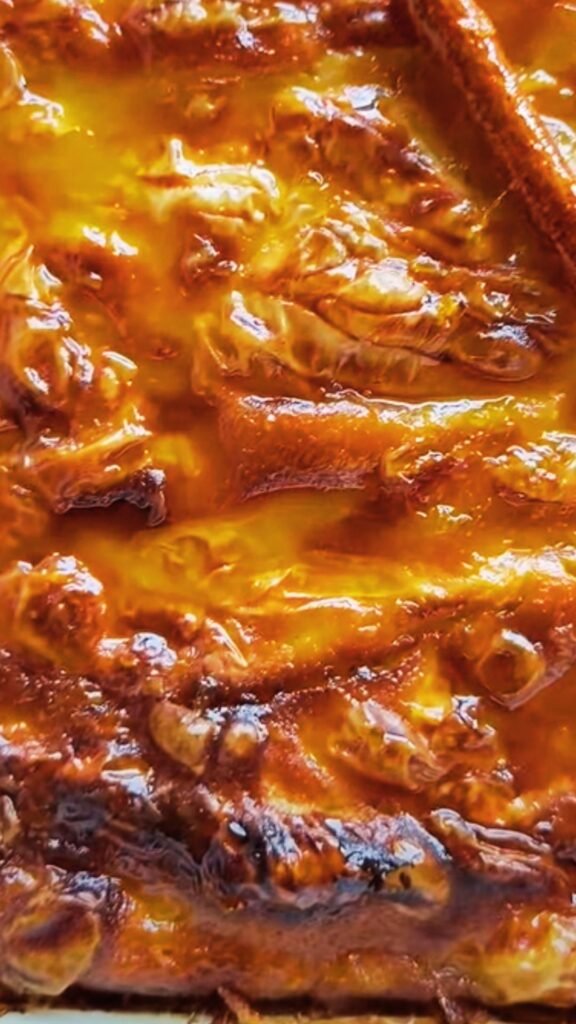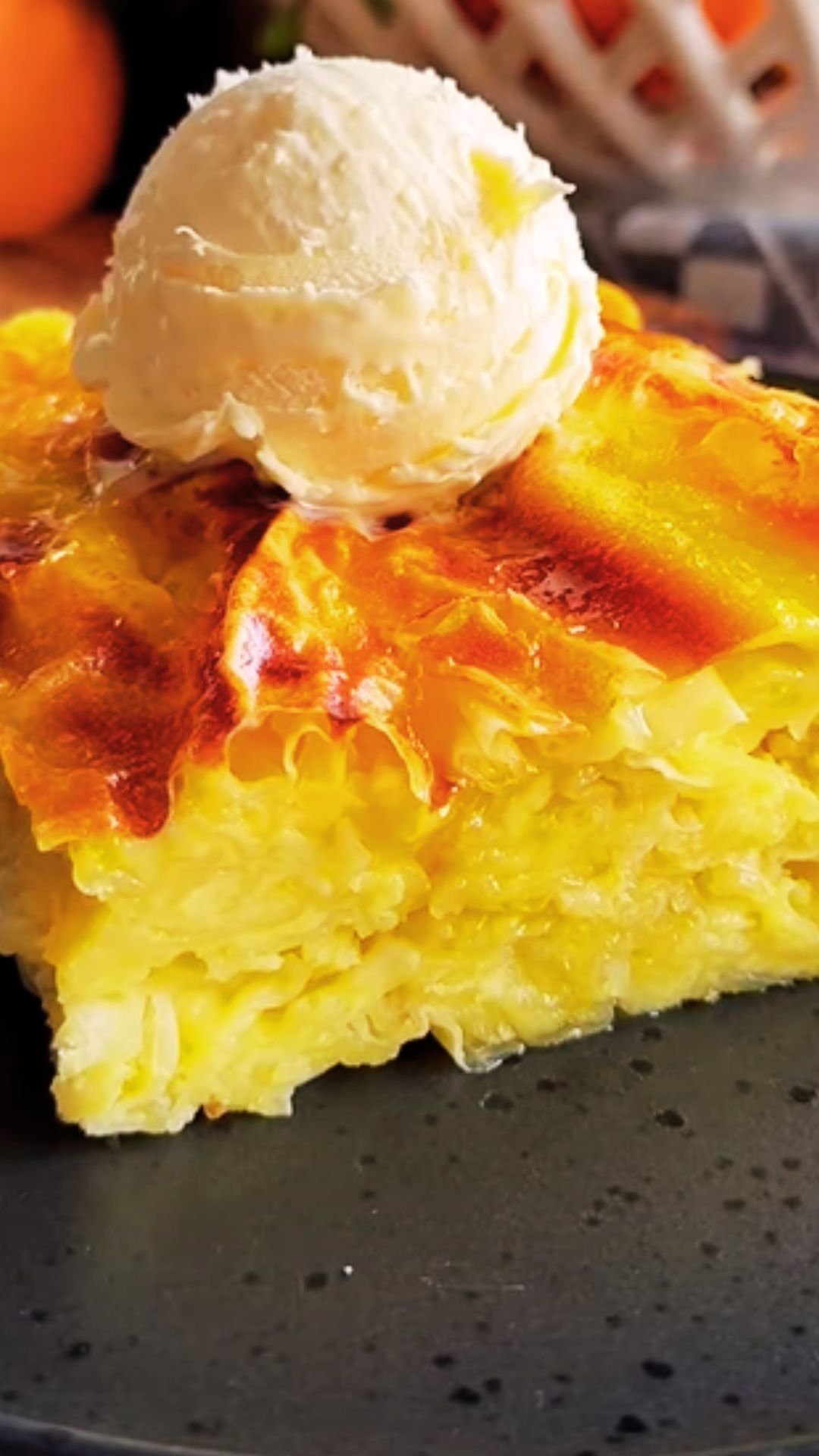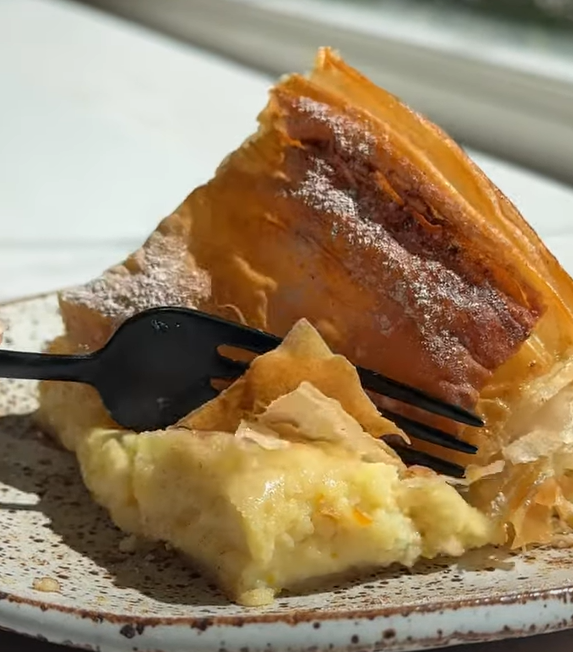When I first encountered Portokalopita in a small taverna in Crete, I knew I had discovered something extraordinary. This isn’t just another cake – it’s a testament to Greek culinary ingenuity, transforming humble phyllo pastry into a dessert that’s simultaneously rustic and elegant. The name itself tells the story: “portokali” meaning orange and “pita” meaning pie, though this creation transcends any simple categorization.
What makes Portokalopita truly special is its unique approach to phyllo pastry usage. Unlike traditional Greek pastries where phyllo is carefully layered, this recipe celebrates imperfection. The phyllo is deliberately crumpled, creating irregular pockets that soak up the orange-infused custard and syrup, resulting in textures that range from creamy to slightly chewy in the most delightful way.
My journey with this recipe began during a cooking class in Athens, where my instructor, Yiayia Maria, taught me that the secret lies not in precision, but in understanding how ingredients work together. She emphasized that Portokalopita represents the Greek philosophy of making something beautiful from simple ingredients – eggs, milk, oranges, and phyllo pastry transformed into pure magic.
Understanding the Essential Components
Phyllo Pastry Foundation
Phyllo pastry: Paper-thin sheets of unleavened dough that form the structural base of Portokalopita. Unlike other applications where phyllo must remain crisp, here it’s intentionally moistened and softened.
Fresh vs. frozen phyllo: Fresh phyllo offers superior texture and flavor, but frozen varieties work excellently when properly thawed. The key is ensuring the phyllo isn’t brittle when you begin working with it.
Preparation technique: The revolutionary aspect of Portokalopita is how phyllo is handled – crumpled rather than layered, creating natural pockets for custard absorption.
Orange Elements
Fresh orange juice: The primary flavoring agent that infuses every layer with citrus brightness. I always use freshly squeezed juice from Mediterranean oranges when available.
Orange zest: Provides concentrated citrus oils that intensify the orange flavor throughout the dessert. The zest should be organic and pesticide-free.
Orange segments: Optional but recommended for textural contrast and bursts of fresh fruit flavor within the custard layers.
Custard Components
Whole milk: Creates the creamy base that transforms phyllo from crispy pastry to custardy delight. Full-fat milk produces the richest results.
Heavy cream: Adds luxurious richness and helps create the perfect custard consistency that coats every phyllo fragment.
Fresh eggs: Bind the custard and provide structure while maintaining the dessert’s tender texture. Room temperature eggs incorporate more easily.
Traditional Preparation Method
My approach to Portokalopita has evolved through countless attempts, each teaching me something new about this forgiving yet sophisticated dessert. The beauty lies in its adaptability – you can adjust sweetness, citrus intensity, and even texture based on personal preferences.
Phyllo Preparation Process
Begin by removing phyllo from refrigeration approximately one hour before use, allowing it to reach room temperature gradually. Frozen phyllo requires complete thawing, preferably overnight in the refrigerator, then brought to room temperature. This prevents cracking and makes handling significantly easier.
Unroll the phyllo sheets carefully, keeping unused portions covered with a slightly damp kitchen towel to prevent drying. Unlike traditional phyllo applications where individual sheets are used, Portokalopita requires you to work with multiple sheets simultaneously.
Take 3-4 phyllo sheets at once and gently crumple them into irregular shapes, roughly the size of your palm. The goal isn’t uniformity – embrace the natural folds and creases that will become pockets for the custard. Place these crumpled pieces in your prepared baking dish, creating an uneven but distributed layer.
Continue this process until you’ve used approximately half your phyllo, creating the foundation layer. Reserve the remaining phyllo for the top layer, which will be added after the initial custard pour.
Custard Development
The custard requires careful attention to temperature and timing. In a heavy-bottomed saucepan, combine whole milk and heavy cream over medium-low heat. Heat until small bubbles form around the edges – this indicates the perfect temperature without scalding.
While milk heats, whisk eggs vigorously in a separate bowl until pale and slightly thickened. Gradually add sugar, continuing to whisk until the mixture becomes noticeably lighter in color and texture. This process, called “creaming,” incorporates air and creates the foundation for a smooth custard.
Add freshly grated orange zest to the egg mixture, releasing those essential citrus oils. The amount can be adjusted based on desired intensity – I prefer a generous hand with zest for maximum orange impact.
When milk reaches proper temperature, remove from heat and allow to cool slightly. The tempering process is crucial here: slowly pour a small amount of warm milk into the egg mixture while whisking constantly. This prevents the eggs from scrambling while gradually raising their temperature.
Continue adding warm milk gradually, whisking continuously, until approximately half the milk has been incorporated. At this point, you can add the egg mixture back to the remaining milk in the saucepan, whisking constantly over low heat until the custard thickens enough to coat the back of a spoon.

Assembly and Baking Process
Preheat your oven to 350°F (175°C) and position the rack in the center position. This temperature ensures even cooking without over-browning the phyllo before the custard sets properly.
Pour the warm custard over the first layer of crumpled phyllo, using a ladle to distribute evenly. The custard should flow between the phyllo pieces, filling gaps and coating surfaces. Gently shake the pan to help distribution, but avoid stirring, which could break the phyllo unnecessarily.
Add the remaining crumpled phyllo pieces on top, distributing them evenly but maintaining the rustic, irregular appearance that characterizes authentic Portokalopita. Press gently to ensure the phyllo pieces make contact with the custard below.
Pour any remaining custard over the top layer, allowing it to seep down through the phyllo. The top layer should be mostly covered but with some phyllo edges exposed – these will become beautifully golden during baking.
Detailed Recipe Measurements and Instructions
| Ingredient Category | Specific Ingredient | Quantity | Notes |
|---|---|---|---|
| Phyllo Base | Frozen phyllo pastry | 1 lb (450g) | Thawed completely |
| Unsalted butter | 4 tbsp | Melted, for pan | |
| Custard | Whole milk | 4 cups (950ml) | Room temperature preferred |
| Heavy cream | 1 cup (240ml) | 35% fat content | |
| Large eggs | 6 | Room temperature | |
| Granulated sugar | 3/4 cup (150g) | Adjust to taste | |
| Orange zest | 3 large oranges | Organic preferred | |
| Vanilla extract | 2 tsp | Pure vanilla only | |
| Syrup | Fresh orange juice | 1 1/2 cups (360ml) | Strained |
| Granulated sugar | 1 cup (200g) | For syrup | |
| Water | 1/2 cup (120ml) | Filtered preferred | |
| Orange zest | 2 oranges | Additional for syrup | |
| Cinnamon stick | 1 | Optional enhancement |
Step-by-Step Execution
Preparation Phase (30 minutes) Remove phyllo from freezer 4-6 hours before use, allowing complete thawing. Bring eggs and milk to room temperature – this ensures smoother custard integration and prevents temperature shock during cooking.
Preheat oven to 350°F (175°C) and generously butter a 13×9 inch baking dish. The butter prevents sticking and adds subtle richness to the phyllo edges that contact the pan.
Zest oranges using a microplane grater, avoiding the bitter white pith. Reserve zested oranges for juice extraction. Fresh zest provides significantly more flavor than dried alternatives.
Custard Creation (20 minutes) Heat milk and cream in a heavy saucepan over medium-low heat until steaming but not boiling. Small bubbles around the edges indicate proper temperature.
Whisk eggs in a large bowl until foamy, then gradually add sugar while continuing to whisk. The mixture should become pale and slightly thickened. Add orange zest and vanilla, whisking to distribute evenly.
Temper the egg mixture by slowly adding hot milk while whisking constantly. This gradual process prevents scrambling and ensures smooth custard consistency.
Return mixture to saucepan and cook over low heat, stirring constantly with a wooden spoon, until custard coats the back of the spoon. This typically takes 8-10 minutes and requires patience to avoid overheating.
Assembly Process (15 minutes) Work quickly but carefully with phyllo to prevent excessive drying. Crumple sheets into palm-sized pieces, embracing irregular shapes that will create interesting texture variations.
Layer half the crumpled phyllo in the prepared baking dish, distributing evenly but maintaining the rustic appearance. Pour warm custard over phyllo, allowing it to flow naturally between pieces.
Add remaining phyllo on top, gently pressing to ensure contact with custard below. Pour any remaining custard over the surface, filling gaps and coating exposed phyllo edges.
Baking Timeline (45-55 minutes) Bake in preheated oven for 45-55 minutes, until the top is golden brown and custard is set. The center should spring back lightly when touched, and edges should pull slightly from pan sides.
During baking, prepare the orange syrup by combining orange juice, sugar, water, and additional zest in a saucepan. Bring to a boil, then reduce heat and simmer for 10-15 minutes until slightly thickened.
Syrup Application and Finishing Techniques
The syrup application represents the final transformation that elevates Portokalopita from good to extraordinary. This step requires timing and technique to achieve optimal absorption without creating soggy texture.
Remove the cake from oven when golden and set, but still warm. The internal temperature should reach approximately 160°F (71°C) for proper custard setting. Allow cooling for exactly 10 minutes – this brief rest period allows slight firming while maintaining receptiveness to syrup absorption.
Using a skewer or thin knife, create small holes throughout the surface, penetrating about halfway through the cake. These channels facilitate syrup distribution and prevent surface runoff.
Pour the warm syrup slowly and evenly over the entire surface, allowing each addition to absorb before adding more. The process should take 5-7 minutes, ensuring complete absorption without oversaturation.
The finished Portokalopita should glisten with absorbed syrup while maintaining structural integrity. Proper syrup application creates a moist, flavorful dessert that improves with time as flavors meld and intensify.
Nutritional Information and Dietary Considerations
| Nutritional Aspect | Per Serving (1/12 of recipe) | Daily Value % |
|---|---|---|
| Calories | 385 | 19% |
| Total Fat | 18g | 28% |
| Saturated Fat | 11g | 55% |
| Cholesterol | 145mg | 48% |
| Sodium | 220mg | 10% |
| Total Carbohydrates | 52g | 19% |
| Dietary Fiber | 2g | 7% |
| Sugars | 38g | – |
| Protein | 8g | 16% |
| Vitamin C | 35mg | 39% |
| Calcium | 180mg | 14% |
Dietary Modifications
Gluten-Free Adaptation: Traditional phyllo contains gluten, but specialized gluten-free phyllo pastry is available in Mediterranean markets. The texture differs slightly, becoming more tender, but the overall result remains delicious.
Reduced Sugar Version: The sugar content can be reduced by up to 25% in both custard and syrup without significantly impacting texture. Natural sweeteners like honey can substitute for half the granulated sugar, adding complexity to the flavor profile.
Dairy Alternatives: For lactose-intolerant individuals, whole milk can be replaced with full-fat coconut milk or cashew cream. These alternatives provide richness while maintaining custard consistency, though the flavor profile shifts slightly.
Egg Reduction: While eggs are crucial for custard structure, the recipe can accommodate one fewer egg if necessary, though the final texture becomes slightly less firm.
Serving Suggestions and Presentation Ideas
Portokalopita serves beautifully both warm and at room temperature, offering different textural experiences depending on serving temperature. Warm servings emphasize the custard’s creaminess, while room temperature portions highlight the phyllo’s unique texture and allow flavors to fully develop.
Traditional Presentation
Cut into squares or diamonds using a sharp knife, cleaning the blade between cuts to maintain clean edges. Each piece should showcase the irregular phyllo layers suspended in set custard.
Dust lightly with powdered sugar just before serving, creating visual contrast against the golden surface. Fresh orange segments or candied orange peel provide elegant garnish options that reinforce the dessert’s citrus theme.
Modern Plating Techniques
Individual portions can be plated with accompaniments like Greek yogurt sweetened with honey, providing creamy contrast to the dessert’s texture. A drizzle of additional orange syrup around the plate adds visual appeal and extra flavor.
Fresh mint sprigs complement the orange flavors while adding color contrast. Toasted almonds or pistachios provide textural variety and reflect traditional Greek flavor pairings.
Beverage Pairings
Greek coffee or strong espresso balances the dessert’s sweetness while honoring its Mediterranean origins. Herbal teas, particularly chamomile or mountain tea, provide gentle accompaniment that doesn’t compete with the orange flavors.
For special occasions, a digestif like Metaxa or ouzo extends the Greek theme, though these should be served separately rather than incorporated into the dessert.
Storage and Make-Ahead Strategies
| Storage Method | Duration | Quality Notes |
|---|---|---|
| Room Temperature | 2 days | Optimal texture and flavor |
| Refrigerated | 5 days | Custard firms, phyllo softens |
| Frozen | 1 month | Texture changes significantly |
| Individual Portions | 3 days refrigerated | Convenient serving option |
Optimal Storage Conditions
Store covered at room temperature for up to 48 hours, allowing flavors to meld while maintaining ideal texture balance. The dessert actually improves during this period as the phyllo continues absorbing flavors while the custard sets completely.
Refrigeration extends storage life but alters texture – the custard becomes firmer while phyllo softens further. Some prefer this texture variation, finding it reminiscent of traditional Greek galaktoboureko.
Make-Ahead Preparation
The entire dessert can be assembled up to 24 hours before baking, covered tightly and refrigerated. Allow to come to room temperature for 30 minutes before baking, and add 5-10 minutes to the baking time to account for the chilled start.
Syrup can be prepared up to three days in advance and stored refrigerated. Warm gently before application to ensure proper absorption.
Troubleshooting Common Issues
Custard Problems
Scrambled custard: Usually results from overheating during preparation. Prevention involves constant stirring and temperature monitoring. If scrambling occurs, strain the custard through fine mesh to remove lumps.
Thin custard: Indicates insufficient cooking time or temperature. Return to low heat and continue cooking while stirring until proper consistency develops.
Lumpy texture: Often caused by inadequate tempering when combining hot milk with eggs. Thorough whisking during tempering prevents this issue.
Phyllo Challenges
Brittle phyllo: Results from over-drying during preparation. Keep unused phyllo covered with damp towel and work quickly during assembly.
Soggy bottom: Indicates excessive moisture or insufficient baking. Ensure proper oven temperature and adequate baking time for complete custard setting.
Uneven browning: Usually caused by incorrect oven rack position or temperature variations. Center rack positioning and oven thermometer verification help achieve even results.
Syrup Issues
Poor absorption: Occurs when cake is too cool or syrup too thick. Ensure both cake and syrup are appropriately warm during application.
Oversaturation: Results from too rapid syrup application. Pour slowly, allowing each addition to absorb before continuing.
Regional Variations and Cultural Context
Throughout Greece, Portokalopita variations reflect local preferences and available ingredients. Island versions often incorporate local citrus varieties or add almonds reflecting Byzantine influences. Northern regions sometimes include subtle spice additions like cinnamon or cloves.
Historical Significance
This dessert represents the Greek tradition of resourcefulness – transforming leftover or broken phyllo into something extraordinary. The technique likely developed as home cooks sought ways to use phyllo scraps rather than discarding them.
The orange emphasis reflects Greece’s agricultural abundance, particularly in regions like Argos and Laconia, where citrus cultivation has ancient roots. The combination of phyllo and citrus represents the marriage of Byzantine pastry techniques with indigenous Greek flavors.
Modern Interpretations
Contemporary Greek pastry chefs have elevated Portokalopita while respecting its rustic origins. Some add mascarpone for extra richness, while others incorporate orange blossom water for enhanced floral notes.
Restaurant versions sometimes feature individual presentations or incorporate additional citrus varieties for complexity. However, the fundamental appeal remains the contrast between sophisticated flavor and humble presentation.
Questions and Answers
Q: Can I use store-bought orange juice instead of fresh? I strongly recommend fresh orange juice for optimal flavor. Store-bought varieties often contain preservatives and lack the bright, complex flavor essential to authentic Portokalopita. If you must use commercial juice, choose varieties labeled “not from concentrate” and add extra orange zest to compensate for diminished flavor intensity.
Q: What’s the difference between Portokalopita and Galaktoboureko? While both desserts use phyllo and custard, their preparation methods differ significantly. Galaktoboureko features carefully layered phyllo sheets with custard between layers, creating distinct, crispy layers. Portokalopita uses crumpled phyllo mixed throughout the custard, creating a more integrated, cake-like texture with varied textural pockets.
Q: Can I prepare this dessert without eggs? Eggs are essential for custard structure and cannot be completely eliminated. However, you can reduce the egg count by one or two if necessary, though the final texture will be less firm. Vegan alternatives exist using cornstarch and plant-based milk, but the result differs significantly from traditional Portokalopita.
Q: Why does my phyllo become too soggy? Soggy phyllo usually results from excessive moisture in the custard or insufficient baking time. Ensure your custard reaches proper consistency before assembly, and bake until the center is completely set. The phyllo should maintain some textural integrity even after absorbing custard and syrup.
Q: Can I freeze leftover Portokalopita? While freezing is possible, it significantly alters the texture. The custard becomes denser and the phyllo loses its characteristic texture variation. If you must freeze portions, wrap tightly and consume within one month. Thaw slowly in the refrigerator and consider serving at room temperature to minimize textural changes.
Q: How do I know when the custard is properly cooked? Properly cooked custard coats the back of a spoon and leaves a clear line when you draw your finger across it. The mixture should be thick enough to hold its shape momentarily when dropped from the spoon but still flow smoothly. Temperature-wise, it should reach approximately 170°F (77°C).
Q: Can I add other flavors to the basic recipe? Absolutely! Traditional variations include lemon instead of orange, or combinations of citrus fruits. Some regions add almonds, pistachios, or even a touch of mastika (mastic) for unique flavor profiles. However, maintain the basic custard structure and phyllo technique for authentic results.
Q: What causes uneven texture in the finished dessert? Uneven texture often results from inadequate custard distribution during assembly or inconsistent phyllo preparation. Ensure custard flows evenly between phyllo pieces and that crumpled phyllo maintains relatively consistent sizes for uniform texture throughout the dessert.
Q: Is it normal for the top to crack during baking? Light surface cracking is normal and actually desirable, indicating proper custard setting. However, excessive cracking suggests too high baking temperature or overbaking. Monitor carefully during the final 10 minutes of baking and reduce temperature slightly if extensive cracking develops.
Q: How can I intensify the orange flavor? Beyond using fresh juice and zest, consider adding a small amount of orange extract (start with 1/2 teaspoon) or incorporating finely chopped candied orange peel into the custard. Some bakers add orange segments between phyllo layers for bursts of fresh fruit flavor throughout the dessert.


